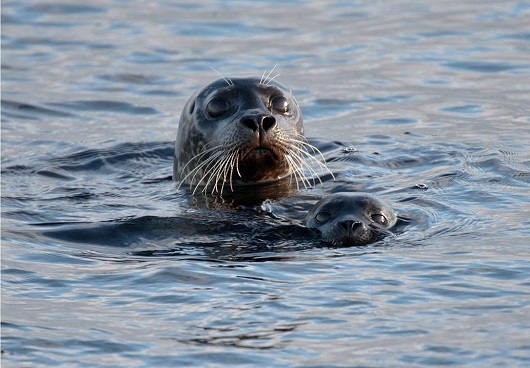Effects of powerful man-made underwater sounds

Noise from pile driving during offshore wind turbine construction could be damaging the hearing of harbour seals around the UK, researchers have found.
They say more research is needed on how noise affects marine mammals’ hearing and into engineering solutions to reduce noise levels. The study is published today in the British Ecological Society’s Journal of Applied Ecology.
There are currently 1,184 offshore wind turbines around the coast of the UK, between them generating around 4GW of power. The next round of construction, which began in 2014, will see hundreds more turbines installed to generate a further 31GW, yet we know little about the impact of construction noise on sea mammals’ hearing.
The team of ecologists from the University of St Andrews attached GPS data loggers to 24 harbour seals while offshore wind turbines were being installed in the Wash in 2012. The data loggers collected information on the seals’ locations and their diving behaviour, relaying the information onshore via the mobile phone network.
They then combined this data with information from the wind farm developers on when pile driving was taking place to produce models which predicted the noise each seal was exposed to, and compared this with noise levels that other studies show cause auditory damage.
The model revealed that half of the tagged seals were exposed to noise levels that exceeded hearing damage thresholds.
Offshore wind turbines are installed using pile drivers – essentially large hammers that drive the foundation posts into the sea bed – which produce short pulsed sounds every few seconds.
The lead author of the study Dr Gordon Hastie of the University’s Sea Mammal Research Unit said, “These are some of the most powerful man-made sounds produced underwater, noise capable of travelling large distances underwater.”
Although we have some information on the effects of noise on harbour seals’ hearing, very little is known about the impact of the pulsed sounds produced by pile driving. However, a wealth of data exists on the effect of noise on humans and other terrestrial species, data which shows that powerful pulsed sounds can damage mammals’ hearing.
“Like most marine mammals, harbour seals have very sensitive underwater hearing at a much broader range of frequencies than humans,” said Dr Hastie. “Seals probably use underwater hearing during the mating season and to detect and avoid predators. They may also rely on their hearing for navigation and finding prey.”
The team’s results are important because seals are protected under European law and any impacts that might affect their conservation status need to be assessed prior to the construction of wind farms.
Dr Hastie said, “Our predictions highlight that seals may routinely be exposed to potentially hazardous levels of underwater noise during pile driving, with potential implications for the conservation status of some populations. To reduce these potential impacts, regulators and industry are currently investigating engineering solutions to reduce sound levels at source, and methods to deter animals from damage risk zones in order to potentially reduce auditory damage risk.”
The team now hopes to validate their predictions by making hearing measurements on seals using special ‘seal headphones’, monitoring individual seals’ movements at sea, and collecting long-term data on their growth, reproduction and survival.
Harbour seals live around the coasts of the North Atlantic and North Pacific from the subtropics to the Arctic. Around 30% of European harbour seals are found in the UK. An epidemic of phocine distemper virus cut numbers along the east coast of England by half in 1988, and although a second outbreak in the Wash in 2002 resulted in a decline of 22%, the population has increased dramatically since 2009.
Harbour seals weigh in at around 80-100kg and are long lived, living up to 30 years. They dive from the surface to depth to catch a variety of prey, from sand eels and herring to octopus and squid. They haul out in sheltered waters, usually on intertidal sand banks and estuaries, pups are born in June and July and the seals moult in August.
Notes to news editors
Gordon Hastie, Deborah Russell, Bernie McConnell, Simon Moss, Dave Thompson, Vincent Janik (2015). ‘Sound exposure in harbour seals during the installation of an offshore wind farm: predictions of auditory damage’, doi: 10.1111/1365-2664.12403, is published in Journal of Applied Ecology on 20 May 2015.
Dr Gordon Hastie is available for interview. Photos are available. Contact Corporate Communications.
For copies of the paper and photos, contact Becky Allen, British Ecological Society Press Officer, mob: +44 (0)7949 804317, email: [email protected]
Journal of Applied Ecology is published by Wiley-Blackwell for the British Ecological Society. Contents lists are available at www.journalofappliedecology.org
The British Ecological Society was founded in 1913 and is the oldest ecological society in the world. A learned society and registered charity, the BES supports ecological science through its five academic journals, other publications, events, grants and awards.
Issued by the University of St Andrews Communications Office, contactable on 01334 467310 or [email protected].
Category Research